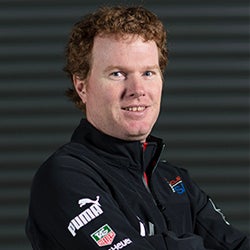He may never have intended to find a career in sailboat design, but life-long sailor and mechanical engineering alumnus Andrew Gaynor has essentially reached the pinnacle in the industry. He helped design the cutting-edge catamaran that won the 2013 America’s Cup in 23 minutes and delivered new speed and excitement to the world’s greatest sailboat regatta.
“Through the whole design process you’re feeling the competition because you see what other teams are doing,” Gaynor said. “You’re in this constant competition to design a better boat and that’s where your energy comes from.”
Gaynor spent the run-up to the race focused on designing the boat’s wing-sail that catches the wind and propels the boat to speeds of upwards of 40 knots. After modeling designs, conducting finite element analyses and drawing production blueprints, the wing-sail he designed became perhaps the most prominent part of the $100 million boat.
Gaynor’s accidental career got its start at URI when he joined a team to design, construct and race a solar-powered boat that took second place a national competition. After graduation, he went to work for engineering companies designing masts and next-generation wind turbine blades and military armaments. When a friend called in 2005 and asked for help designing for the America’s Cup, Gaynor left his job to gamble on a new career. It’s a gamble that’s paid off.
In 2008, Gaynor launched his own company, JAG Composites, and found a niche consulting on the design and analysis of innovative composite structures. He served on the design teams for the 2010 America’s Cup winning BMW Oracle USA team and the semi-finalist 2007 Italian team. He also designed masts for competitors in the 2008 and 2011 around-the-world Volvo Ocean Race.
And he’s hoping that Team USA calls him again for the next America’s Cup so he can design an even faster, better boat.

